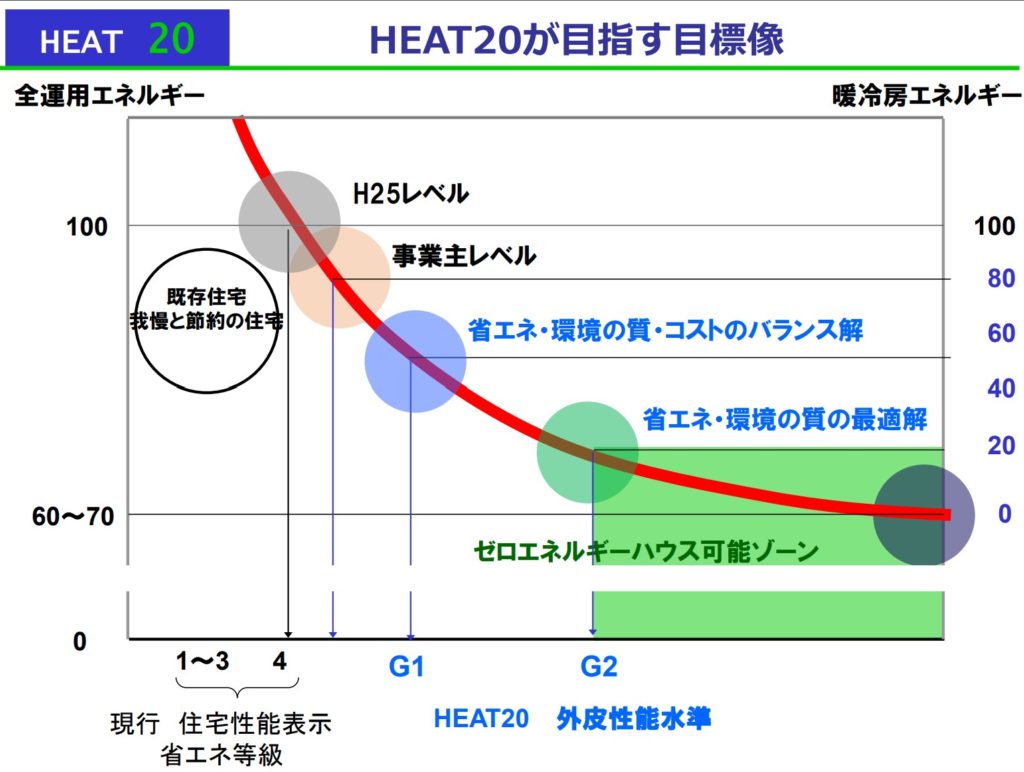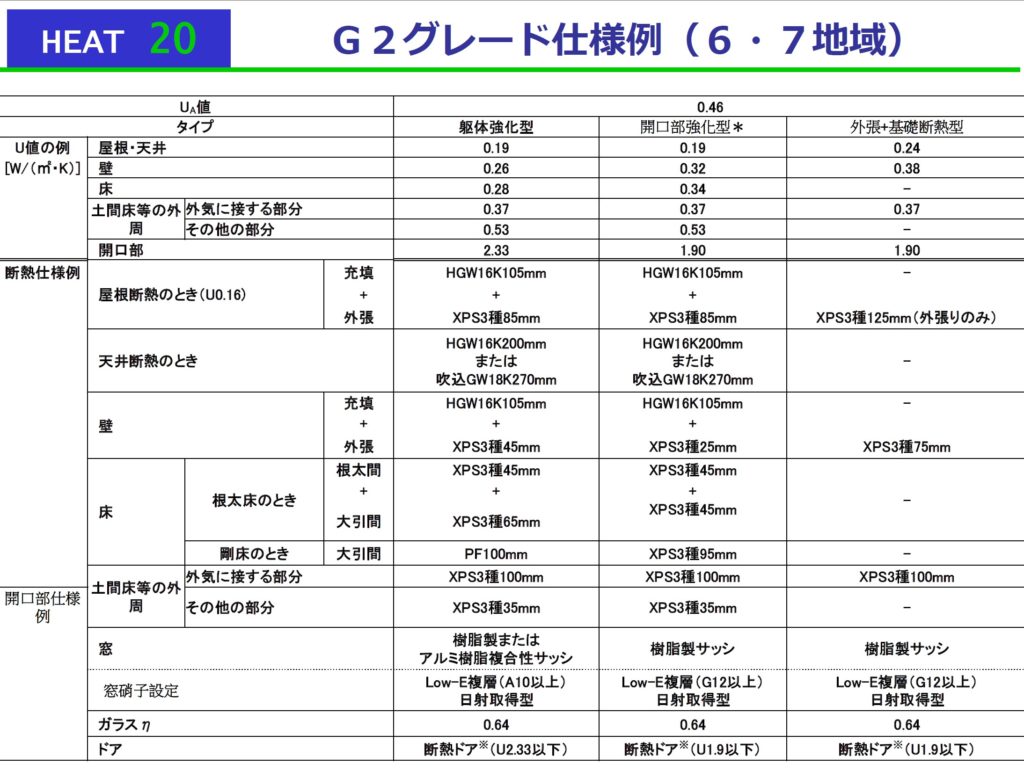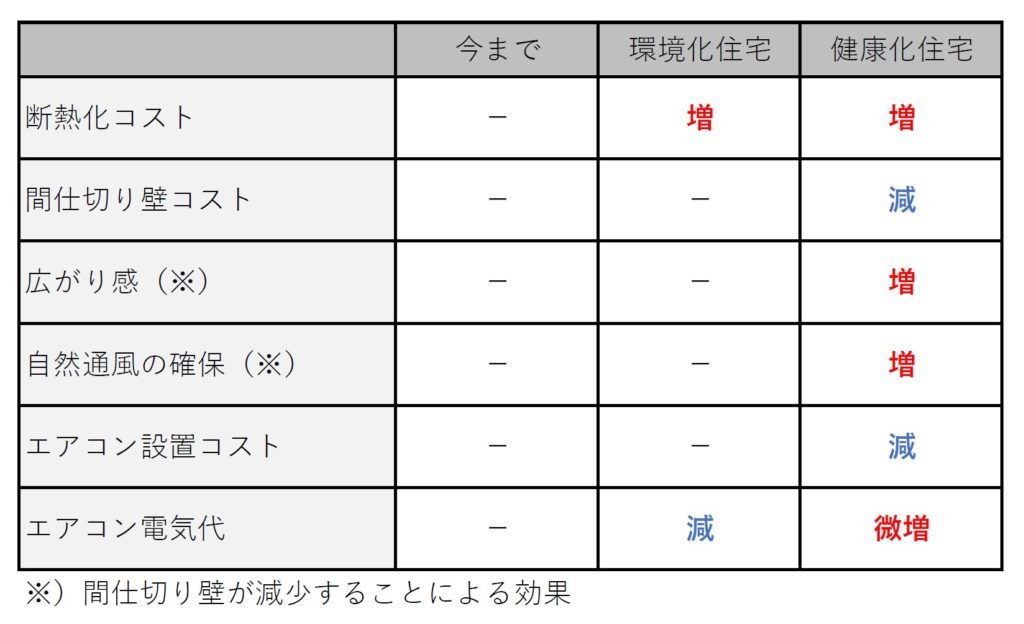13 外皮の断熱性能① -Insulation performance of the outer skin(1)-
English is after the Japanese description. #english
妻「住宅新築するときに、ZEHとか高断熱化ってどこでも言ってるよね。」
夫「どこも高断熱なら、特に気にしなくてもいいんじゃない?今でも寒いとかないし。。。」
妻「そうねー。エアコン運転費用も安くなるみたいだし。」
夫「高断熱化のコストと相殺してくれるんなら、いいかもね。あんまりエアコンも好きじゃないし。」
上の夫婦の会話が違和感なく、断熱に対する知識がこのくらいだと、消費者として大変もったいない状態です。断熱の効果は、もちろんエアコン運転費用を削減する効果もありますが、それ以上に輻射熱を低減して、夏でも涼しい環境を作ったり、集中力(生産性)を向上させる効果も報告されています。それらの効果を得るためには、断熱性能についても把握しておいた方が良いでしょう。
結論としては、ZEHや日本の省エネ基準よりも高い断熱性能の指標である、HEAT20のG1又はG2レベルまで上げることで、断熱の本来の効果を獲得できます。
以下では具体的な数値で、断熱性能と効果を整理しておきます。
①省エネ、②輻射熱抑制、③上下温度差対策が有効に機能する断熱性能を目標とすると、HEAT20 G2レベルの断熱性能を満たすことで、これらが可能となる(※1、2)と報告されているため、仮にこれを目標と定め、実際の外皮厚などを検証してみる。

同報告会の資料から、東京の事例(6地域)を引用させて頂いた。このUa値(=0.46)については、たとえはZEH住宅の6地域の基準値がUa=0.6、ZEH+住宅がUa=0.5であることと比較しても、さらに高い断熱性能値であることが分かる。

外皮(屋根・壁・床・開口など室内外を区分する部位の総称)の断熱材1層では必要断熱性能が確保できないため、断熱材を2層(2枚重ね)にした上、開口部をアルミでなく、高性能樹脂又は木製サッシを採用する必要がある。特に玄関や1階の風呂場では断熱ラインが切れやすいため、特に注意が必要である。加えて、土間床等の外周に「100㎜」断熱材を配置するには、平面・断面的な建築的収まりの工夫も必要となる。
今までの一般的な住宅の断熱性能が低すぎたとも言えるが、外皮に関してコストは今まで以上にかかることになる。しかし、その代わりにこの目標値まで到達できれば、建物内での温熱環境の均一化が可能となるため、エアコン台数の減や間仕切りの減といったコスト減が可能になる。加えて温熱環境的な快適性や限られたスペースでの広がりのある室内空間ができる。実際のコストは条件により変わるが、メリット・デメリットとして、凡そ下図記の様に整理できる。(※当事務所作成)
エアコン電気代について、同じ時間を利用した場合は、「微増」であるが、実際はエアコンを利用しなくても良い期間が長くなる場合が多く、年間としての電気代は「低減」する見込みであるが、利用実態や建設地環境にも影響されるので、個別の判断が必要となるポイントでもある。

※1)(一社)20年先を見据えた日本の高断熱住宅研究会著(2021)HEAT20 設計ガイドブック2021 (株)建築技術
※2)野中俊宏 他著(2021)図解風の力で住まいを快適にする仕組み (株)エクスナレッジ
-Insulation performance of the outer skin(1)-
Wife: “When you build a new house, everywhere is talking about ZEH or high insulation.”
Husband “If everywhere is highly insulated, you don’t have to worry about it. Even now, I don’t feel cold…”
Wife: “That’s true. It seems the cost of running the air-conditioner will be cheaper too.”
Husband: “If it offsets the cost of high insulation, it might be good. I don’t really like air conditioning either.”
If the above conversation between the husband and wife was sounded smooth, it is a very wasteful situation for the consumer. The effect of insulation is, of course, to reduce air-conditioning operating costs, but more than that, it is also reported to reduce radiant heat, creating a cooler environment even in summer, and to improve concentration (productivity). In order to achieve these effects, it is advisable to understand the insulation performance.
In conclusion, the true benefits of insulation can be achieved by raising the insulation performance to the G1 or G2 level of HEAT20, an index of insulation performance higher than ZEH and Japanese energy efficiency standards.
In the following, insulation performance and effects are organised by specific values.
If (1) energy saving, (2) radiant heat suppression and (3) insulation performance that effectively functions to prevent temperature differences between upper and lower levels are targeted, it is reported that these can be achieved by meeting the HEAT20 G2 level of insulation performance (*1, 2), so we will tentatively set this as a target and verify the actual external skin thickness and other factors.
The Tokyo case study (6 regions) was quoted from the material of the same report meeting. This Ua value (= 0.46) can be seen to be an even higher insulation performance value, even if compared to the standard value of Ua = 0.6 for ZEH homes in the six regions and Ua = 0.5 for ZEH+ homes.
As the required insulation performance cannot be ensured with only one layer of insulation in the outer skin (the general term for the parts that divide the interior and exterior, such as roofs, walls, floors and openings), it is necessary to use two layers of insulation and high-performance plastic or wooden sashes instead of aluminium for openings. Particular attention should be paid to the entrance and first-floor bathrooms, where the insulation line is easily broken. In addition, the placement of ‘100 mm’ insulation around the perimeter of earthen floors, etc., requires an architectural adjustment in terms of plan and section.
It can be said that the insulation performance of ordinary houses up to now has been too low, but costs will be higher than ever with regard to the outer skin. However, if the target values can be reached, it will be possible to achieve a more uniform thermal environment within the building, which will reduce costs by reducing the number of air conditioners and partitions. In addition, thermal environmental comfort and an expansive interior space in a limited space can be achieved. The actual costs will vary depending on conditions, but the advantages and disadvantages can be summarised as shown in the diagram below. (*Compiled by KAEDe Architects).
In reality, the period when air conditioning is not required is often longer, so the annual electricity bill is expected to decrease, but this is a point that needs to be judged on an individual basis, as it is affected by actual usage and the environment of the site.
(2021) HEAT20 Design Guidebook 2021 by the Society for the Study of Highly Insulated Houses in Japan 20 Years Ahead (Architectural Technology Co., Ltd.)
(2021) Illustration of the mechanism for making your home comfortable with the power of wind, by Toshihiro Nonaka et al.
